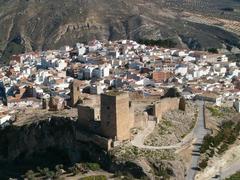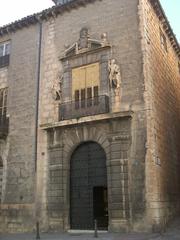Arab Baths of Jaén: Complete Guide to Visiting Hours, Tickets, and Historical Insights
Date: 14/06/2025
Introduction
The Arab Baths of Jaén (Baños Árabes de Jaén), nestled beneath the Renaissance Palacio de Villardompardo in the heart of Jaén, Spain, are the largest and among the best-preserved Islamic bathhouses (hammams) in the Iberian Peninsula. These 11th-century baths, built atop earlier Roman foundations, offer a compelling lens into the city’s layered heritage, reflecting the architectural and cultural exchanges of Al-Andalus. Today, they function as a vibrant cultural monument, integrated with museums and exhibition spaces, providing visitors with a unique opportunity to explore both the Islamic and Christian epochs of Jaén’s history.
This comprehensive guide details the baths’ origins, architectural features, visiting hours, ticketing, accessibility, guided tours, and nearby attractions—equipping you with all the information needed for a rewarding visit.
For official updates and deeper insights, consult the Baños Árabes Jaén Official Website, Arqueo Al-Andalus, and Piccavey.
Table of Contents
- Origins & Historical Evolution
- Architectural Highlights
- Social and Cultural Role
- Rediscovery and Restoration
- Modern-Day Experience
- Visitor Information
- Frequently Asked Questions (FAQ)
- Tips for a Memorable Visit
- Conclusion & Recommendations
- References and Further Reading
Origins & Historical Evolution
Constructed in the 11th century during the Taifa period of Al-Andalus, the Arab Baths of Jaén were built atop remnants of Roman structures, attesting to a long-standing bathing tradition in the region (Arqueo Al-Andalus). Known as Hammam al-Walad (“Bath of the Child”), the baths originally served both hygienic and social functions for Jaén’s Muslim community.
After the Christian conquest in 1246 by Ferdinand III of Castile, the baths continued to be used for a time but were eventually repurposed as a tannery and later concealed beneath the Palacio de Villardompardo, built at the end of the 16th century. This act of concealment inadvertently preserved the baths for centuries (Piccavey).
Rediscovered in 1913, the baths underwent significant restoration and today remain a testament to Jaén’s multicultural past.
Architectural Highlights
Spanning approximately 450 square meters, the Baños Árabes de Jaén follow the archetypal structure of Islamic bathhouses, with four primary chambers:
- Vestibule (Bayt al-Maslaj): The entrance hall, with a white marble floor and a ceiling pierced by 18 star-shaped skylights.
- Cold Room (Bayt al-Barid): A cooling area featuring a half-barrel vault and 15 skylights.
- Warm Room (Bayt al-Wasti): The central, most impressive room, boasting a large dome supported by horseshoe arches atop eight columns (some of Roman origin) and illuminated by star-shaped skylights.
- Hot Room (Bayt al-Sajun): Heated by a hypocaust system, this chamber also features alcoves and 15 skylights.
Decorative elements include geometric Almohad-era stucco work and original wall paintings. The architectural layout and ingenious heating system highlight the fusion of Roman engineering with Islamic design (Arqueo Al-Andalus).
Social and Cultural Role
In medieval Al-Andalus, hammams such as the Baños Árabes de Jaén were essential venues for hygiene, ritual purification, socializing, and even business. Their proximity to the city center and architectural grandeur suggest a prestigious status, serving all social classes. The experience of moving through the sequence of chambers—cold, warm, and hot—provided not just physical cleansing but spiritual and communal enrichment.
Rediscovery and Restoration
The baths were rediscovered in 1913 and declared a National Monument in 1931. Restoration began in the 1930s, resumed in the 1970s, and was completed in 1984, earning the Medalla de Honor de Europa Nostra for heritage conservation. Today, the baths are part of the Centro Cultural Palacio de Villardompardo, which also houses the Museum of Arts and Popular Customs and the International Museum of Naïve Art (Baños Árabes Jaén Official Website).
Modern-Day Experience
Visitors today can explore the atmospheric chambers of the baths, learn about their history through interpretive panels and guided tours, and enjoy the rich cultural offerings of the Palacio de Villardompardo. The site is known for its peaceful ambiance, enhanced by the interplay of light through the star-shaped skylights and the echo of centuries-old rituals.
Visitor Information
Visiting Hours (as of June 2025)
- Tuesday to Saturday: 9:00 AM – 10:00 PM
- Sunday and Holidays: 9:00 AM – 3:00 PM
- Monday: Closed
Note: Always verify current hours on the official website before your visit.
Admission and Tickets
- Admission is free of charge for the baths and museums in the Palacio de Villardompardo (bbqboy.net).
- Guided tours (often combining the baths, cathedral, and olive oil tasting) are available for around $32.46 per person. Book via platforms like GetYourGuide or Civitatis.
Accessibility
- The baths and palace are wheelchair accessible, with ramps and elevators. Some uneven surfaces remain due to the site’s historic nature. Notify staff in advance for assistance (civitatis.com).
Guided Tours and Special Events
- Guided tours in Spanish and English provide in-depth historical and architectural context.
- The site regularly hosts art exhibitions, workshops, and concerts. Check for current events on the official website.
Travel Tips
- Wear comfortable shoes for stone and marble floors; bring a light jacket for the cool interiors.
- Photography is permitted without flash.
- Allow 1.5–2 hours for a thorough visit.
- Visit early or late for a quieter experience.
Nearby Attractions
- Jaén Cathedral: A Renaissance masterpiece.
- Santa Catalina Castle: Panoramic views and historic exhibits.
- Jewish Quarter: Winding medieval streets.
- Local Tapas Bars: Experience regional cuisine.
Frequently Asked Questions (FAQ)
Q: What are the visiting hours?
A: Tuesday to Saturday, 9:00 AM – 10:00 PM; Sunday and holidays, 9:00 AM – 3:00 PM; closed Mondays.
Q: Is there an admission fee?
A: No, admission is free.
Q: Are guided tours available?
A: Yes, guided tours can be booked online and often include other city highlights.
Q: Is the site accessible to visitors with reduced mobility?
A: Yes, but some areas may be challenging due to historic architecture.
Q: Can I take photographs inside?
A: Yes, but flash is discouraged.
Tips for a Memorable Visit
- Combine your visit with other city landmarks for a full cultural day.
- Relax at the palace’s rooftop café for panoramic city views.
- Check for special exhibitions or events during your planned visit.
- The best seasons to visit are spring and autumn for pleasant weather and fewer crowds.
Conclusion & Recommendations
The Baños Árabes de Jaén are a captivating window into the city’s Islamic and Christian past, architectural grandeur, and ongoing cultural vibrancy. Their exceptional preservation, free admission, and central location make them an essential stop for any traveler to Jaén. Enhance your experience by joining a guided tour, exploring the adjoining museums, and enjoying the rooftop terrace.
For the latest details, events, and ticket information, always consult the Baños Árabes Jaén Official Website. Download the Audiala mobile app for interactive maps, audio guides, and exclusive content to enrich your visit.
References and Further Reading
- Baños Árabes Jaén Official Website
- Arqueo Al-Andalus - Baños Árabes de Jaén
- Piccavey - Jaén City and Cathedral
- bbqboy.net – Andalusia’s Underrated City: Jaén
- Veronika’s Adventure – Jaén 3-Hour Tour: Cathedral, Arab Baths, Olive Oil Tasting
- Civitatis – Arab Baths & Villardompardo Palace Tour
- Laguiaviajera – Baños Árabes de Jaén
- The Viva La Vita – Jaén Travel Guide
- Turispanish – Jaén Spain Tourism
- Try Travel – Things to Do in Jaén



